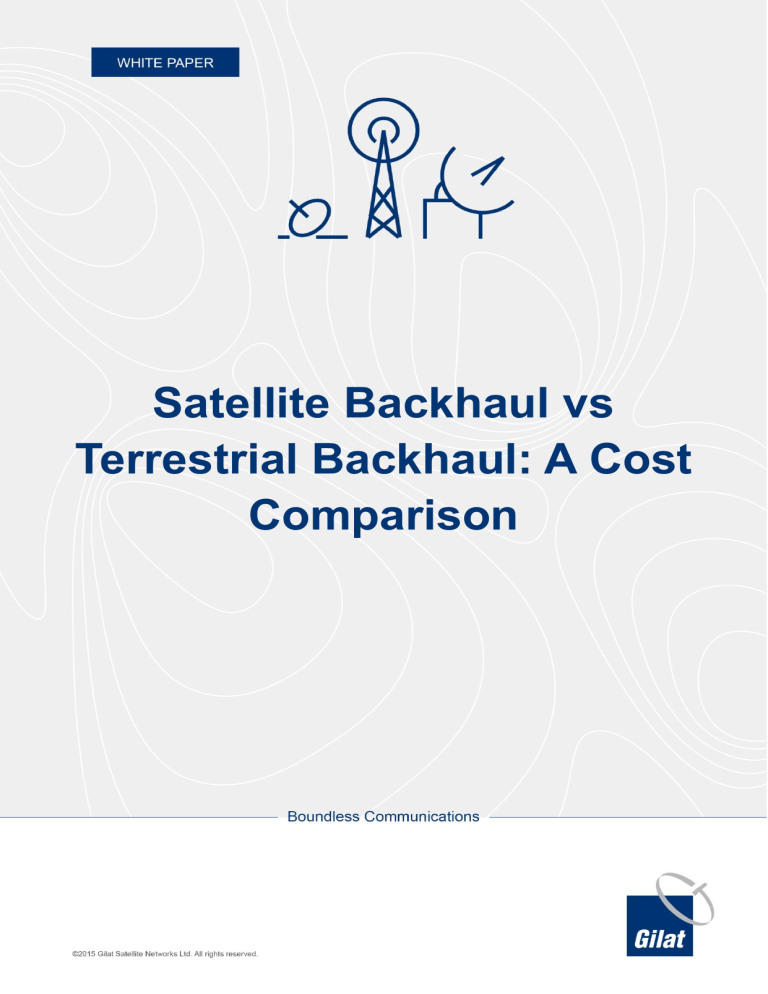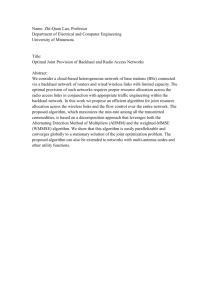
Satellite Backhaul vs
Terrestrial Backhaul: A Cost
Comparison
A perfect storm
3
Network deployment comparison
4
Semi-rural terrestrial backhaul deployment
4
Rural terrestrial backhaul deployment
5
TCO Comparison
6
July 2015
©2015 Gilat Satellite Networks Ltd. All rights reserved.
LTE Backhaul over Satellite
p. 2
A perfect storm
The mobile industry and the satellite industry have worked in parallel
for decades, occasionally targeting the same market but mostly not.
While mobile operators satisfied the vast demand for personalized onthe-move connectivity in population centers, satellite focused on
connectivity in remote regions.
But then - two phenomena converged.
One was that mobile traffic became increasingly data-driven. This
meant that the throughput requirements for mobile networks would
need to grow exponentially. As the diagram below shows, using the
United States as an example, mobile network traffic is expected to
double between 2015 and 2017.
Figure 1: Mobile Traffic Forecasts
The proliferation of data over mobile has spurred the adaption of
higher communications standards such as 4G/LTE. While these
standards have not yet been implemented everywhere, they are surely
on their way, and standards with even higher capacity – 5G and
beyond – will follow.
At the same time, advances in the satellite industry have slashed the
cost of bandwidth. High-Throughput Satellites (HTS) offer significantly
increased capacity, reducing bandwidth costs by as much as 70
July 2015
©2015 Gilat Satellite Networks Ltd. All rights reserved.
LTE Backhaul over Satellite
p. 3
percent. This breakthrough has helped position satellite
communication as a cost-effective alternative for delivering broadband
while reducing operating expenses.
The crucial role of
backhaul
The ramping up of networks to handle data traffic has an overarching
need: a backhaul transmission mechanism that is reliable, quickly
deployable, and cost-effective.
Another consideration affecting the cost impact is the backhauling
access scheme. When providing a satellite backhaul link, the question
of bandwidth efficiency is crucial. The goal is to save money by using
the exact amount of bandwidth that meets the subscriber’s
performance needs, and no more. Satellite offers access schemes with
either fixed or adaptable bandwidth in the download as well as the
upload direction: TDM/TDMA or TDM/SCPC. Selecting the right
access scheme depends on network traffic patterns. Whichever
scheme is chosen, the goal is to reduce costs by optimizing bandwidth
consumption.
With satellite costs plummeting on one hand, and demand for data
skyrocketing on the other, a unique value proposition is taking shape
for mobile network operators – backhaul of cellular data over satellite.
In this paper, we'll take a closer look at how this model works in rural
and semi-rural environments.
Network
deployment
comparison
Let's take a closer look at the options for mobile network operators
looking to expand by comparing setup and ongoing expenses for
satellite and terrestrial networks.
For purposes of this sample, we assumed the following:
• Deployment of a 100-eNodeB network with full connectivity to
Internet core
• Average of 100-125 concurrent users per site at peak time
• User experience – 100Mbps per user at average use of 10-15MB
use in peak hour
Let's start with a typical deployment of a semi-rural network with
terrestrial (microwave) backhaul.
Semi-rural terrestrial
backhaul
deployment
In semi-rural locales, a blend of short- and long-range links cover the
towns and smaller communities, which may be relatively remote or
bunched together. In one or more hops, these links funnel into two
July 2015
©2015 Gilat Satellite Networks Ltd. All rights reserved.
LTE Backhaul over Satellite
p. 4
fiber PoPs, which in turn link to the LTE core. On roads connecting
communities, coverage is full.
Figure 2: Deployment of Terrestrial Backhaul in Semi-Rural
Area
Rural terrestrial
backhaul
deployment
Now let's look at a rural locale covered by terrestrial backhaul.
Figure 3: Deployment of Terrestrial Backhaul in Rural Area
Due to a sparse population and large distances between communities,
we can assume a larger proportion of long-range links relative to
shorter ones. In one or more hops, these links funnel into ten fiber
July 2015
©2015 Gilat Satellite Networks Ltd. All rights reserved.
LTE Backhaul over Satellite
p. 5
PoPs, which in turn link to the LTE core. On roads connecting
communities, coverage may be intermittent.
Figure 4: Deployment of Satellite Backhaul in SemiRural/Rural Area
Rural/semi-rural
satellite backhaul
deployment
TCO Comparison
In these same locales, a satellite-based backhaul solution allocates
one VSAT per eNodeB and can be deployed rapidly. Each VSAT is
connected via satellite directly to the fiber PoP; this PoP connects to
the Gilat SkyEdge II-c hub, which generally sits in close proximity to
the Internet core. On roads connecting communities, coverage is full.
The above scenario shows that both backhaul methods are viable, but
the bigger question is which is more cost-effective. For that, we'll have
to delve into the numbers. We'll compare Total Cost of Ownership
(TCO) figures, factoring in the variables than can affect cost.
July 2015
©2015 Gilat Satellite Networks Ltd. All rights reserved.
LTE Backhaul over Satellite
p. 6
Figure 5: Microwave deployment. Price assumptions
Figure 6: Satellite deployment. Price assumptions
The totals of these estimated expenses are compared side-by-side in
Figure 7 below.
July 2015
©2015 Gilat Satellite Networks Ltd. All rights reserved.
LTE Backhaul over Satellite
p. 7
Figure 7: Backhaul TCO Comparison Over 5 Years
CAPEX – for terrestrial backhaul, capital expenses primarily consist of
creating microwave links and laying fiber for from the rural PoPs to the
Internet core. For satellite backhaul, this consists of purchasing and
installing VSATs, antennas and a hub.
OPEX – for terrestrial backhaul, operational expenses consist of
leasing spectrum, powering and leasing space for microwave towers,
and running costs for the fiber hop to the Internet core. For satellite
backhaul, this consists of purchasing MHz from a satellite operator.
Maintenance – as per industry best practices, this is measured at 15%
of CAPEX.
Reviewing the figures above, several data points stand out:
Multi-spot beam bandwidth, with a per Mhz cost half of widebeam bandwidth, is the most cost-effective backhaul solution
The more rural the region, the less cost-effective terrestrial
backhaul becomes
As CAPEX is a lower percentage of the overall expense in a
satellite network, its maintenance costs are lower
Other differences between terrestrial and satellite are harder to
quantify in dollars but nonetheless affect the bottom line. Satellite
infrastructure is portable, so it can be reused wherever it's needed.
Time to market is shorter. Licensing is per country, not per site. These
July 2015
©2015 Gilat Satellite Networks Ltd. All rights reserved.
LTE Backhaul over Satellite
p. 8
are just a handful of the many considerations that mobile network
operators make when evaluating backhaul mechanisms.
To complement its satellite network offering, Gilat offers a complete
package of Network Operation Centers, installation and field support.
This one-stop service gets a network up and running quickly, and frees
up mobile network operators to focus on what they do best – sell a
high-quality service.
July 2015
©2015 Gilat Satellite Networks Ltd. All rights reserved.
LTE Backhaul over Satellite
p. 9
www.gilat.com
©2015 Gilat Satellite Networks Ltd. All rights reserved.



